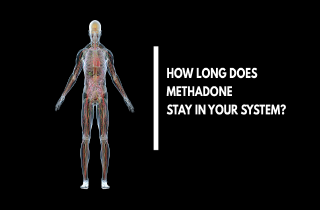Methadone can be detected in the blood, urine and saliva. In urine, methadone metabolites can test positive for 2-4 days after last dose.
Here, you will find a thorough review of methadone detection times, drug testing methods and addiction liability of methadone. Please leave your questions about methadone use, abuse or addiction at the end. We answer and respond to all legitimate comments with a prompt, researched reply.
How do you take methadone?
Methadone is available in oral solution, liquid concentrate, tablet, and powder. Methadone is most often ingested orally, and other routes of administration (snorting, injecting, etc.) are reliable indicators of methadone misuse or abuse.
What is methadone used for?
Methadone is a full mu opioid agonist which is used in opioid addiction treatment programs. Methadone specifically suppresses symptoms of opioid withdrawal methadone for 24 hours or longer or is used in combination with social and medical services in long term methadone maintenance programs. An opioid itself, at proper dosing, methadone usually reduces cravings for and the need to take stronger opioids. Methadone is also an effective analgesic and may provide pain relief when other pain relievers are ineffective.
Methadone has been recognized by the DEA as a Schedule II narcotic drug, which means that although it has a medical use, the risk for dependence, abuse and addiction are relatively serious. These risks increase if you take methadone to get high.
Peak levels and half life of methadone
Methadone’s elimination half-life is between 8-59 hours. More specifically, the half-life of (R,S)-methadone is 15-60 hours, and 10-40 hours for (R)-methadone. The duration of analgesic action is between 4-8 hours. And although methadone reaches peak concentration in blood plasma at around 4 hours after dosing, it can be detected in the blood 30 minutes after intravenous or oral ingestion.
What is important to understand about methadone is that methadone’s full analgesic effect is usually not attained until after 3-5 days of dosing. And methadone can induce respiratory depression or cardiovascular problems as you start taking it. These risks need to be evaluated and assessed by you and your prescribing doctor before dosing begins.
Methadone drug testing
Most methadone drug tests are done via urine screen. Blood screens and saliva drug tests for methadone are also possible but are not used regularly in clinical settings. Although some doctors believe that concentrations of methadone in blood plasma tests are the “gold standard” to assess treatment compliance, blood testing is relatively impractical, costly, and difficult. Additionally, Methadone and other opioids can be screened via oral fluid, but this method is not currently used in practice very often.
Plus, you should know that proper samples for methadone contain at least two of its metabolites in order to be properly identified. Testing for metabolites prevents you from simply adding methadone to a sample.
So how long does methadone stay in the body? Methadone typically can be detected in urine for 2-4 days after use. Cutoff concentrations for a positive methadone drug test are at 300 ng/ml for both the intial and the confirmation drug screen.
Methadone and addiction
Methadone has an abuse liability similar to that of morphine. Like other opioids used for analgesia, methadone can abused for its euphoric effect. But methadone is also used clinically in long term clinical settings to offset withdrawal and cravings for harder drugs. So how do you know if you are becoming addicted to methadone or not?
Methadone addiction is characterized by compulsive use, use for non-medical purposes, and continued use despite harm or risk of harm. If you think that you have a problem with methadone, you probably do. Getting honest is the first step to getting help. In today’s world drug addiction is a treatable disease and not a stigmatized moral issue. Many treatment options are available, and we invite your questions or requests for help here.
Problems with methadone?
Please let us know. We will do our best to find you answers to your questions, or local resources that can help you find treatment.
Reference sources: Drug testing in oral fluid
FDA Info for Healthcare Professionals about Methadone Hydrochloride
FDA approved dolophine hydrochloride drug label
TIP 43 Medication-Assisted Treatment for Opioid Addiction in Opioid Treatment Programs
NIDA Research Monograph Series 73 Urine Testing for Drugs of Abuse










Related Posts